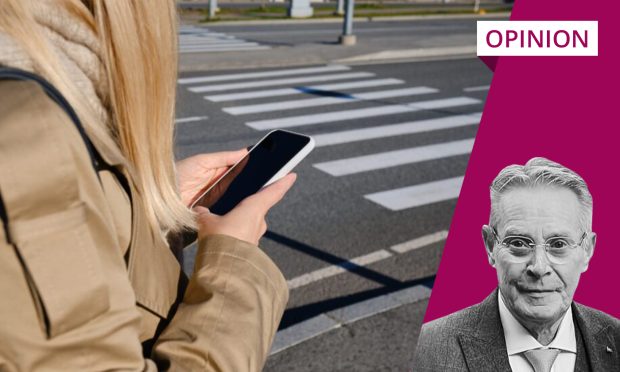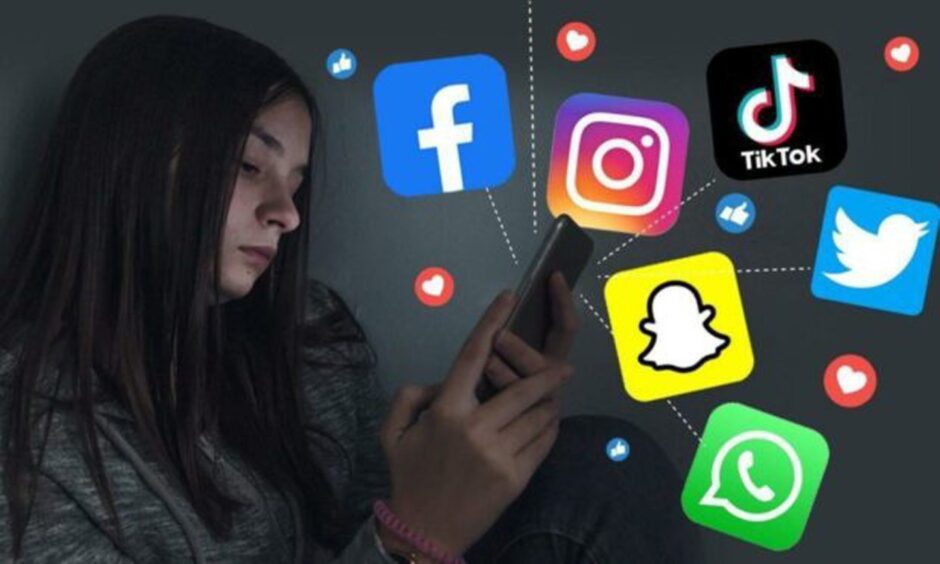I was staring in fascination at a young woman crossing a road in front of me the other day as I waited at a red traffic light in Aberdeen.
Before woke-police put me in cuffs for a “prima facie” case of inappropriate behaviour, please allow me to place all the facts in front of you before judging me.
I was carrying out serious research, honestly.
My head twisted 180 degrees from right to left as I followed her progress.
Engrossed with looking at her mobile phone, which she was glued to as she walked.
As though she was locked away in another world, oblivious to her potential dangerous surroundings; she never looked up once as she traversed my complete field of vision.
And she didn’t pause for a second as she stepped into the main road – her crossing procedure was carried out in one continuous manoeuvre without looking up.
I supposed she could hear bleep-bleeps from the lights telling her it was safe to cross, but even so – it seemed a bit risky to me, placing all her trust in the somewhat unpredictable hands of fellow road users.
Two things struck me in particular.
I wouldn’t even drive through a green light these days without carefully checking if it was safe, particularly in that split second when you are pulling away after the lights change.
I’ve seen too many near misses with idiot drivers still coming through on red from the other direction.
For example, an elderly neighbour of mine was almost run over near here as she tried to cross the road with her Zimmer frame after a driver jumped a light and shot out from a side road.
She wasn’t hurt, but it was a terrible shock and lucky escape.
Idiot drivers who give way on green
Then there are those idiot drivers who actually give way on green when they have priority – that really is an accident waiting to happen to those following behind.
And let’s not mention the cyclists and takeaway delivery-drivers who simply ignore our tattered version of the Highway Code; it used to be a good read.
The other thing was that the girl with the phone was so absorbed that she wasn’t able to concentrate on anything else.
Just like children at school whose concentration and learning capability are disrupted by phone chatter which demands instant attention.
Mobile phones are an essential part of life, but also a trap which actually immobilises us.
Teachers are constantly battling against the pervasive presence of this digital intruder into school life – and government ministers are not immune from being caught out “in class”, it’s claimed.
Take hapless Scottish Health Secretary Neil Gray and his Oasis tickets saga as an example.
Was he able to concentrate on affairs of state while knowing all along that his mobile was burning a hole in his pocket, clicking away in a queue for Oasis tickets?
Not a great example when head teachers like Claire McGonigal in the Highlands are trying to make a stand against inappropriate mobile-phone use among her pupils.
Full marks to Grantown Grammar School for taking a lead in its community.
And it is a community problem, after all.
Parents buy phones, but in terms of policing them – and their children – that particular genie has jumped out of the lamp and run away, I fear.
It’s refreshing to see her taking a lead in the community as schools always used to do.
Almost guiding parents, too; a role which was blown off course in recent times as schools were too scared to act over pupil discipline after Scottish Government policy appeared to put “untouchable” children on a pedestal.
The total phone ban seems to be working well in Grantown.
I whiled away a few minutes checking the mobile-phone rules at Kirkwall Grammar School while I was at it.
Only because I believe Orkney-born Gray is an old boy.
They also restrict their use, but concede they are also an essential learning tool when used properly – “as well as good preparation for the world of work where appropriate mobile phone/device use is expected”.
To be fair, maybe it wasn’t a big deal in his day.
Allegations over his farcical Oasis experience have a serious side.
Especially when he claimed he was fully-focused on chairing an important Alzheimer’s disease meeting at the time.
We’ve all done it: snatched anxious glances at our mobiles over important transactions.
I don’t think he’s in the same territory as his even more hapless predecessor Michael Matheson – unless it gets murkier – but still a bad look for someone of his status.
If you preach down to ordinary people from such lofty heights you are held to a higher level.
It’s always worth remembering that people in public office are just like the rest of us, but often a lot sillier.
David Knight is the long-serving former deputy editor of The Press and Journal




Conversation